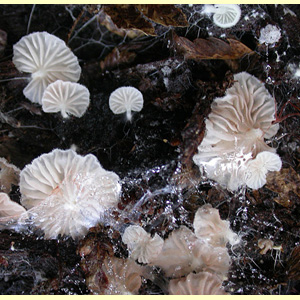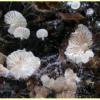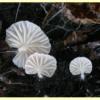
images/Entoloma_section_Claudopus/Claudopus_E2081_2.jpg
Small to medium agaric, growing on the ground, litter, wood or bryophytes, with a pinkish brown spore print. Pileus white, pale, brown or grey, dry, moist or viscid. Lamellae adnexed, adnate or decurrent. Stipe excentric, lateral or absent. Partial veil remnants absent. Spores angular in all views, hyaline, non-amyloid, smooth; germ pore absent. Cheilocystidia present or absent. Lamellar trama regular. Pileipellis a cutis or a trichoderm. Clamp connections present or absent.
Differs from other
Entoloma in the stipe being absent, lateral or excentric. In the field the small, pale fruit-bodies with pink-tinted lamellae can be difficult to distinguish from laterally attached species of
Clitopilus (other) (spores angular only in end view) and also from some pale species of
Crepidotus (with either smooth or warty non-angular spores).
Cheimonophyllum has pure white fruit-bodies, without pink tints to the lamellae, and smooth spores.
Entoloma section
Claudopus (Gill.) Noordel.,
Fungi Europaei 5: 604 (1992).
Six species:
Entoloma byssisedum,
E. depluens and
E. pitereka with
Claudopus minutoincanus,
C. rupestris and
C. viscosus yet to be transferred to
Entoloma.
Keyed out separately from other species of Entoloma because members of the section have the stipe lateral or absent. Section Claudopus is one of two sections of subgenus Claudopus known from Australia, the other section Undati contains species with a central stipe; these are listed and keyed out under Entoloma (other).
W.A., Qld, N.S.W. and Tas. (and probably also N.T., S.A. and Vic.).
In native forests.
On the ground, litter, wood or bryophytes. Sometimes on the thin layer of soil or on bryophytes on the underside of rocks.
Saprotrophic.
Breitenbach, J. & Kränzlin, F. (eds) (1995),
Fungi of Switzerland.
Volume 4. Agarics 2nd part. Edition Mykologia, Lucerne. [
Illustration,
Description and
Microcharacters of
E. byssisedum]
Largent, D.L., Abell-Davis, S.E., Cummings, G.A., Ryan, K.L. & Bergemann, S.E. (2011), Saxicolous species of Claudopus (Agaricales, Entolomataceae) from Australia, Mycotaxon 116: 253–264. [Illustration, Description and Microcharacters of Claudopus rupestris, C. minutoincanus and C. viscosus]
Noordeloos, M. (1988), Entolomataceae, in T.W. Kuyper, M.E. Noordeloos & E.C. Vellinga (eds), Flora Agaricina Neerlandica, Volume 1, 77–177. A.A. Balkema, Rotterdam. [Description and Microcharacters of E. byssisedum and E. depluens, and B&W Illustration of E. byssisedum]
Noordeloos, M.E. & Gates, G.M. (2012), The Entolomataceae of Tasmania. Fungal Diversity Research Series, Volume 22. Springer, Dordrecht. [Illustration, B&W Illustration, Description and Microcharacters for E. pitereka]



